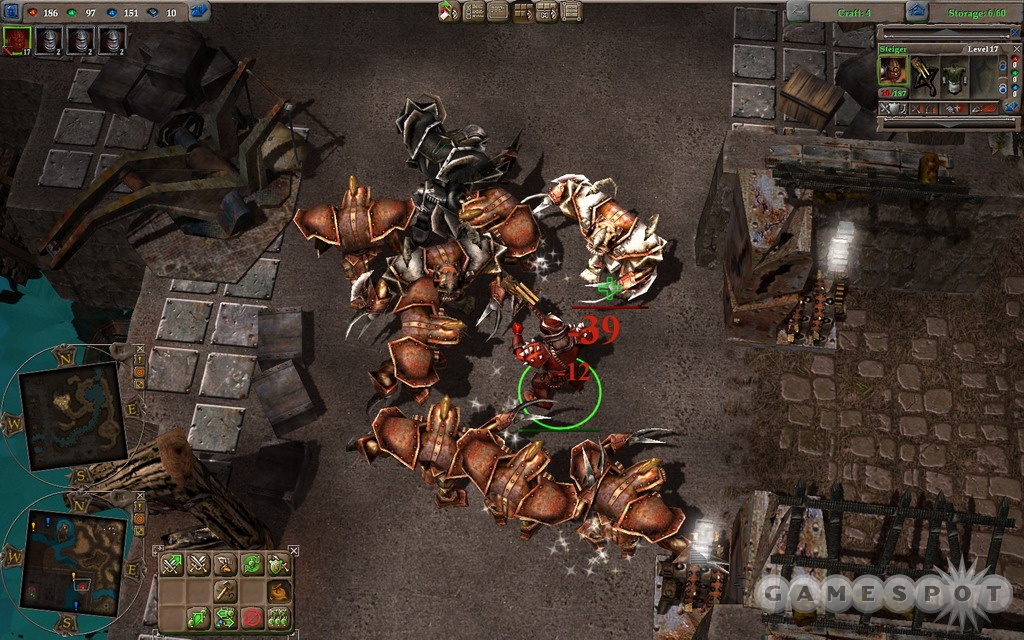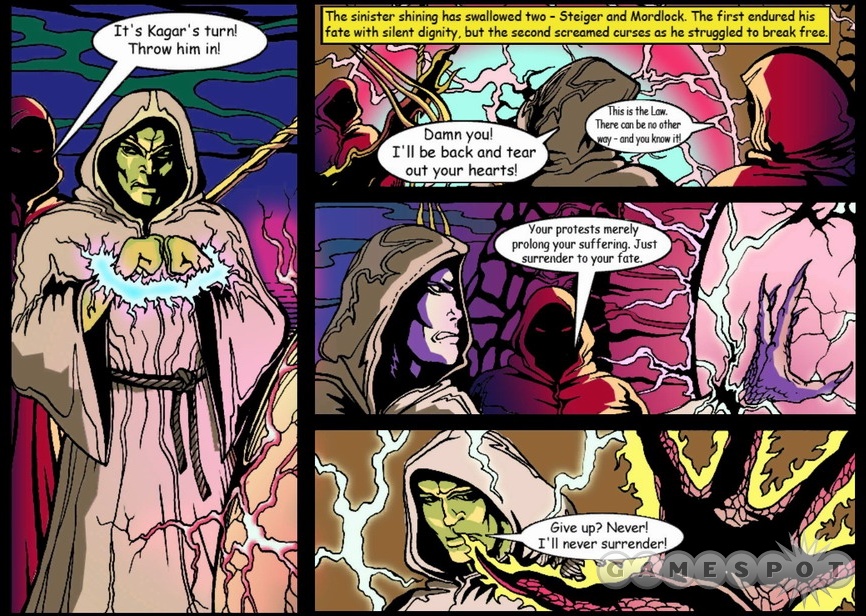Stranger certainly lives up to its name. This role-playing/real-time strategy hybrid is decidedly strange in every respect, from its bizarre setting to its unusual game mechanics and its gawky interface. Russian developer Fireglow Games seems to have set out to make something rather offbeat, but then followed this philosophy so far off the beaten path that the end product turned into a surreal, inept jumble of half-baked ideas. Despite a couple of interesting innovations and some traditional hacking-and-slashing that sticks close to a familiar formula, the game is simply too odd and too clumsily made to appeal to either RPG or RTS gamers.

Big problems are posed by the story. Although Stranger resembles a typical action RPG, the tale is incomprehensible, and the backdrop was presumably concocted by someone on a big-time peyote trip. It's hard to understand anything. Tacky comic-book cutscenes dish out crazy stuff about a town populated by wizards and people tossed into an abyss for reasons unknown. A little online research reveals that the story apparently deals with a trio of exiles booted into another dimension for experimenting with forbidden magic, but good luck figuring that out from what you're presented with in the game. For a change, though, this incomprehensibility isn't powered by an unholy mangling of the English language. Fireglow handles the translations from the original Russian quite well, but there simply isn't enough text to explain what's going on. It's as if every comic page in the cutscenes is missing a couple of panels. And the writers really go in for goofy fantasy names that get your head spinning when a bunch of them are crammed into a sentence or two. At one point you're battling Tidderius, master of the Tiddery Citadel, who controls the insidious Lanzrayer, which is vital to defeating the Muneks of Mokkosa. Follow all of that?
Much of the setting is just as disorienting. The landscape mixes alien and surreal, using Day-Glo colors, luminescent lighting, and flora and fauna that seem to have been dropped in from a old Star Trek episode. Much of the soundtrack consists of quirky, synthy tunes that reinforce the mushroom-enhanced vibe of the whole game. Missions in the single-player campaign are really just separate maps with objectives that have nothing to do with each other. Most goals involve a lot of tedious lever pushing, along with battles against boss monsters that require some specific trick to defeat. Monsters themselves are--you guessed it--pretty darn weird. You take on a host of way-out enemies including what appear to be prehistoric butterflies, loads of creepy bugs, orcs who seem to have had their ears flattened out with an iron, and others that defy description. The menagerie here is so off the wall that you almost long for the demons and undead that take up space in every other action RPG.
Although the basic idea is a straightforward mix of a Diablo-style clickfest RPG with RTS staples such as gathering resources and hiring mercenaries (who serve as party members in place of old-fashioned recruited NPCs), the interface is a mess. Instead of the paper-doll interface that RPGs have been leaning on for inventory management for more than a decade, the game uses a lot of dragging and dropping. For instance, to equip a sword, you have to pull up the inventory and then drag the sword either to the appropriate slot on the separate character sheet or to the character himself on the main game screen. All in all, this works, but feels clunky and is hardly intuitive.
Managing the red, green, and blue crystals that serve both for powering magic and for in-game currency when hiring troops is even more of a pain due to a separate drag-drop menu button and the need to fiddle with sliders. The whole crystal system is poorly organized. You use hundreds of the things to cast spells, and have to shift the different colors back and forth between your hero and a storage box, sort of like manipulating the cash in checking and savings accounts. Topping off the confusion is a fourth resource, metal, which can be acquired mainly by melting down gear. This is kind of a neat idea in that you can recycle old armor and shields into swords and axes, or just use the melted-down result as currency. But despite this concept, the process is nearly identical to selling old junk you no longer need in a standard RPG. The only real difference here is the added step of having to melt down the junk before selling it. So the whole process is really just an extra pain that you'll rarely want to bother with.

When not wrangling with the interface, you're playing a typical action RPG. Quests deal with deeply dull "You scratch my back, I'll scratch yours" stuff where you do favors to open doors, obtain magical artifacts, get a hint about where you're supposed to go next, that sort of thing. And though you're mostly assigned to kill various packs of monsters or bosses to get these rewards, Stranger manages to screw this up with crazy difficulty that forces a lot of grinding. Packs of tough enemies make it impossible to get very far in a level without signing up a big gang of mercenaries to help you out, so you have to spend a half an hour or more killing respawning cannon fodder like giant beetles to earn the crystals needed to go on these hiring sprees. Combat consists of nothing but repetitive right-clicking, too, which numbs the brain awfully fast.
Levels are entirely linear. Maps feature pathways so narrow that you can barely take a step off of the beaten path, let alone leave it entirely, even outdoors. Yet maps can still be perplexing because you often get around courtesy of flying metal grates called terrestres. These contraptions sail sideways across maps as well as up and down from one level to another. This is an okay concept, although the almost MC Escher-like level layout leads to serious confusion at times. Nevertheless, it's a particular problem when ascending or descending to a new area because the camera doesn't automatically follow characters. You soon clue into the fact that you have to manually move the camera to locate your suddenly vanished party of adventurers, but having to do so remains unnecessary and awkward.
Unnecessary and awkward actually sums up Stranger in its entirety. This isn't an entirely awful game, just a mediocre one hampered by some bizarre design decisions, a deeply peculiar setting, and a terrible interface. On second thought, maybe it is awful. At any rate, this is one RPG/RTS hybrid based on hallucinogens that you can safely avoid.